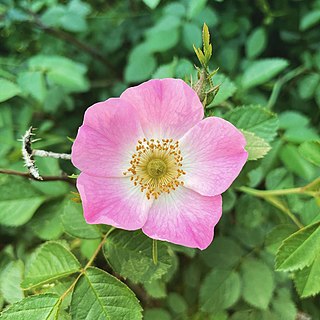
Rosa rubiginosa is a species of rose native to Europe and western Asia.

Prunus africana, the African cherry, has a wide distribution in Africa, occurring in montane regions of central and southern Africa and on the islands of Bioko, São-Tomé, Grande Comore, and Madagascar. It can be found at 900–3,400 m (3,000–10,000 ft) above sea level. It is a canopy tree 30–40 m in height, and is the tallest member of Prunus. Large-diameter trees have impressive, spreading crowns. It requires a moist climate, 900–3,400 mm (35–130 in) annual rainfall, and is moderately frost-tolerant. P. africana appears to be a light-demanding, secondary-forest species.
Artocarpus treculianus is a species of plant in the family Moraceae. It is endemic to the Philippines. It is threatened by habitat loss. Local names include chipuho and tipuho.
Baccaurea odoratissima is a species of plant in the family Phyllanthaceae. It is endemic to the Philippines.
Kibatalia gitingensis is a species of plant in the family Apocynaceae. It is endemic to the Philippines.
Kibatalia macgregori is a species of plant in the family Apocynaceae. It is endemic to the Philippines.
Prunus adenopoda, known locally as ki beusi is a species of plant in the family Rosaceae. It is a tree endemic to Java in Indonesia. It is an endangered species threatened by habitat loss.
Prunus arborea is a species of plant in the family Rosaceae. It is found in Indonesia, Malaysia, Singapore, and Thailand.
Prunus clementis is a species of plant in the family Rosaceae. It is found in Sulawesi and the Philippines.
Prunus grisea is a species of plant in the family Rosaceae. It is found in Malaysia, the Philippines, Singapore, and Taiwan.
Prunus javanica is a species of plant in the family Rosaceae. It is found in India, Indonesia, Malaysia, and Myanmar.

Prunus kinabaluensis is a species of flowering plant in the family Rosaceae. It is found in Borneo and the Philippines.
Prunus laxinervis is a species of plant in the family Rosaceae. It is found in Indonesia and Malaysia.
Prunus malayana is a species of plant in the family Rosaceae. It is a tree endemic to Peninsular Malaysia.
Prunus polystachya, also called bat laurel, is a species of plant in the family Rosaceae. It is endemic to Singapore.
Prunus pulgarensis is a species of plant in the family Rosaceae. It is endemic to the Philippines. It is threatened by habitat loss.
Prunus turfosa is a species of plant in the family Rosaceae, found in; Kalimantan, Indonesia; Sarawak, Malaysia; and possibly Brunei. The plant is restricted to peat swamp forests. As of 1998, the plant was categorised as Endangered by the IUCN on their "Red List" due to licensing of peat swamp forests of Sarawak to be logged.

Prunus fremontii is a North American species of plants in the rose family, known by the common name desert apricot. It takes its scientific name from John C. Frémont. It is found in northern and western Baja California especially, mostly Pacific and western, and the adjacent area of southern California. It also occurs in northern Baja California Sur.

Prunus caroliniana, known as the Carolina laurelcherry, Carolina cherry laurel, Carolina cherry, or Cherry laurel, is a small evergreen flowering tree native to the lowlands of Southeastern United States, from North Carolina south to Florida and westward to central Texas. The species also has escaped into the wild in a few places in California.





